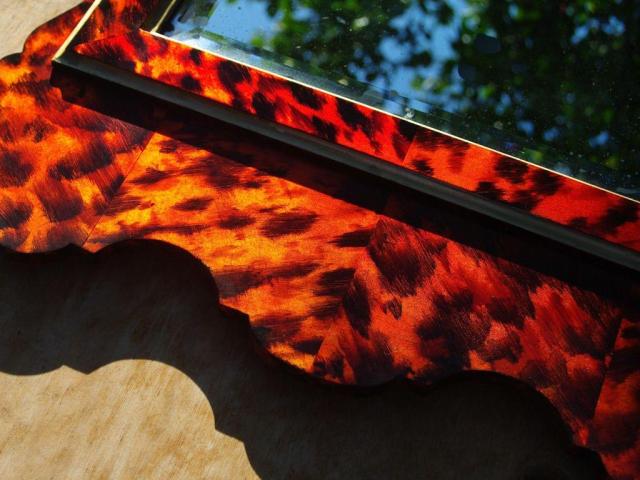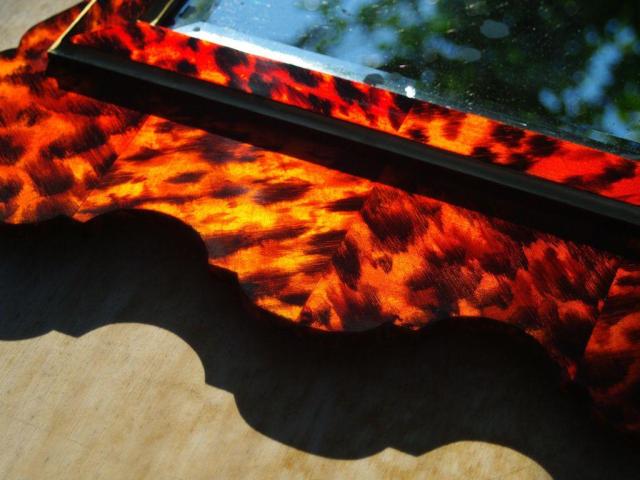As has been mentioned here before, imitating tortoiseshell on furniture has been achieved with varying degrees of realism down the centuries. The tortoiseshell backgrounds of japanned work often consisted of nothing more complex than random daubs of opaque black paint on an opaque coloured (predominantly red) ground, while original standalone testudinal painted finishes usually exhibit more artistic accomplishment. As with grained wood finishes, a proportion of absolute painted tortoiseshell finishes developed into an art form in its own right.
All the same, great strides were made by a number of artists to more accurately recreate natural tortoiseshell, which process involved laying metal foil (brass, gold or silver) on a substrate over which were laid numerous coats of coloured translucent varnish.
Sometime after 1681, Venetian born Joachim Becher developed a method of extracting tar from coal which he used (in conjunction with asphaltum and pitch) to tint varnishes for simulating tortoiseshell.
The ‘projecting genius’, Thomas Algood, (d. 1716), a Northamptonshire Quaker, applied brown lacquer [presumably asphaltum- or tar-based] over irregularly shaped pieces of foil to imitate tortoiseshell.[1]
John Baskerville of Birmingham took out a patent for his simulated tortoiseshell in 1742, describing it as “An imitation … which greatly excells Nature itself both in Colour and hardness.”[2]
The finish on my William and Mary chest of drawers adhered to the practice of building up layers of contrasting paint and translucent varnish to simulate tortoiseshell; however, this girandole attempts to replicate the work of these latter craftsmen using asphaltum and other naturally tinted varnishes over metal foil.
Due to the complexity (and presumable cost) of foil-and-varnish tortoiseshell, it was normally reserved for smaller, more intimate objects for the bed chamber and parlour.
While my chest’s distinctive painted finish displays considerable depth and a charm all of its own, it cannot compete with the naturalistic chatoyance of the girandole’s finish. It’s quite mesmerising and virtually impossible to describe in words or portray in pictures. In the early morning sunlight, the deep scarlet flickers to searing yellow with the merest shift of the body.
 “It’s just a jump to the left…”
“It’s just a jump to the left…”
 “… and then a step to the right.”
“… and then a step to the right.”
The frame and looking glass have been sympathetically aged.
I’m just awaiting the arrival of the candle arm castings to complete the girandole.
Jack Plane

How did you age the mirror??
LikeLike
I covered the ageing and distressing of looking glasses in a previous post.
JP
LikeLike
Amazing finish, have you done this before?!
LikeLike
Yes, though this would be one of the largest pieces I’ve created using this technique.
JP
LikeLike
Glorious!
LikeLike
Any tortoise would be most jealous! Spectacular.
Cheers,
Burbidge.
LikeLike
Absolutely stunning! Inspirational!
LikeLike
I say that everytime I look in a mirror too!
LikeLike
Looking forward to full-length photos of the girandole.
BTW, things seem to be very quiet regarding shoes…
LikeLike
The brassware is still about a week away.
The shoes have softly shuffled off.
JP
LikeLike
Is that “Scarlet Hawksbill” a standard color? And, was it available in a spray can? Seriously…all of the usual kudos – wonderful stuff. I do hope that you won’t forget to show us the finished product, remembering that imitation is the sincerest form of flattery.
LikeLike
Yes, you can purchase Scarlet Hawksbill at your local hardware store, but be sure to ask for it in person as they keep it under the counter to try and prevent taggers and graffiti vandals from getting their hands on it.
JP
LikeLike
Great post! Many years ago, in one of my first restoration attempts I repaired the edge of a hawk’s bill turtle shell with a piece of plastic from a take-away container, coloured and shellacked. I’m not sure, and please don’t shudder, but I think I may have used Vegemite for the splashes of brown. It’s still as good as new.
LikeLike
That’s about all Vegemite is fit for!
JP
LikeLike